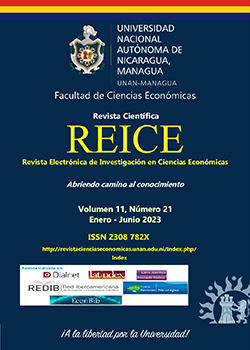Effective functioning of financial services market players in the context of sustainable development of Ukraine's financial system
DOI:
https://doi.org/10.5377/reice.v11i21.16518Keywords:
financial system, financial system components, financial market, financial services, financial resources, financial innovations, financial sector technologiesAbstract
This article aims to investigate the specificities of the effective functioning of financial services market participants in the context of the sustainable development of the Ukrainian financial system. Methodology. The study is conducted using a systematic approach and analytical methods, including legal analysis of legislative changes and comparative analysis, to examine the efficiency of financial services market participants in the context of sustainable development in the Ukrainian financial system. Specifically, a systematic analysis is performed on the activities of key participants in the financial ecosystem of Ukraine, namely banks, insurance companies, credit unions, financial companies, and pawnshops. The findings reveal a notable increase in the magnitude of activities undertaken by the primary participants in the financial market, as evidenced by the growth in their assets, liabilities, yields, and profitability. Concurrently, there has been a reduction in the number of banks, financial companies, insurance companies, credit unions, and pawnshops. This trend can be attributed to the implementation of stricter regulatory requirements and adjustments in the principles, approaches, and tools of macroprudential regulation, which have been instrumental in upholding financial stability within the Ukrainian context. An examination of the dynamics of financial stability indicators in Ukraine demonstrates that the capital adequacy of banks remained steady at 17.6% during the period spanning 2010 to 2022. However, during times of crisis, the level of financial stability in Ukraine experiences a decline, marked by heightened risks of fulfilling obligations, a decrease in Tier 1 risk-weighted capital ratio (RWA), and an increase in the proportion of non-performing loans. The analysis revealed a substantial concentration of non-performing loans (NPLs) in state-owned banks, accounting for approximately 75% of the total NPLs. Furthermore, there exists a notable concentration of loans in the private sector, with an average of 69% observed from 2010 to 2022. The profitability of the financial sector has demonstrated an upward trend since 2018, with particularly notable growth in 2019 and 2021. The level of liquidity serves as an indicator of the deposit sector's ability to withstand fluctuations in the balance sheets of financial service providers. The net open position in Ukraine signifies a significant exposure of financial companies to currency risks, particularly during times of crises, indicating a high degree of vulnerability to currency fluctuations. The practical significance of this article resides in the empirical evaluation of the efficacy displayed by financial services market participants in Ukraine. This assessment is conducted within the framework of implementing a strategy aimed at fostering the development of the financial ecosystem to support sustainable economic growth.
Downloads
References
Akhisar, I., Tunay, K. B., & Tunay, N. (2015). The effects of innovations on bank performance: The case of electronic banking services. Procedia-Social and Behavioral Sciences, 195, 369–375.
Artym-Drohomyretska, Z., Harmatiy, N., Krytska, L., & Harmatii, S. (2022) Statystychnyi analiz diialnosti strakhovykh kompanii Ukrainy instrumentariiem klasternoho analizu [Statistical analysis of activity of insurance companies of Ukraine by cluster analysis tools]. Galician economic journal (Tern.), 74, 1, 7–15 [in Ukrainian].
Buallay, A. (2019). Is sustainability reporting (ESG) associated with performance? Evidence from the European banking sector. Management of Environmental Quality: An International Journal, 30 (1), 98–115.
Caporale, G. M., Rault, C., Sova, A. D., & Sova, R. (2015). Financial development and economic growth: Evidence from 10 new European Union members. International Journal of Finance & Economics, 20 (1), 48–60.
Chiaramonte, L., & Casu, B. (2017). Capital and liquidity ratios and financial distress. Evidence from the European banking industry. The British Accounting Review, 49 (2), 138–161.
Creel, J., Hubert, P., & Labondance, F. (2015). Financial stability and economic performance. Economic Modelling, 48, 25–40.
ECB (2019). Annual Report on supervisory activities 2019. https://www.bankingsupervision.europa.eu/press/publications/annual-report/html/ssm.ar2019~4851adc406.en.html.
European Central Bank – Statistical Data Warehouse (2023 a). Non-performing loans ratio (including cash balances at central banks and other demand deposits). https://sdw.ecb.europa.eu/quickview.do?SERIES_KEY=420.SUP.Q.B01.W0._Z.I7000._T._Z._Z._Z._Z.PCT.C&resetBtn=+Reset+Settings&start=&end=&trans=N.
European Central Bank – Statistical Data Warehouse (2023 b). Return on assets [%], EU countries participating in the Single Supervisory Mechanism (SSM) (changing composition), World (all entities, including reference area, including IO), Percentage. https://sdw.ecb.europa.eu/quickview.do?SERIES_KEY=420.SUP.Q.B01.W0._Z.I2004._T._Z._Z._Z._Z.PCT.C.
Gomber, P., Kauffman, R. J., Parker, C., & Weber, B. W. (2018). On the fintech revolution: Interpreting the forces of innovation, disruption, and transformation in financial services. Journal of management information systems, 35 (1), 220–265.
International Monetary Fund (2023). IFS database. Ukraine. https://data.imf.org/regular.aspx?key=63174545.
Kasman, S., & Kasman, A. (2015). Bank competition, concentration, and financial stability in the Turkish banking industry. Economic Systems, 39 (3), 502–517.
Menicucci, E., & Paolucci, G. (2016). The determinants of bank profitability: empirical evidence from the European banking sector. Journal of financial reporting and Accounting, 14 (1), 86–115. https://doi.org/10.1108/JFRA-05-2015-0060.
Mergaerts, F., & Vander Vennet, R. (2016). Business models and bank performance: A long-term perspective. Journal of Financial Stability, 22, 57–75.
Ozili, P. K. (2018). Impact of digital finance on financial inclusion and stability. Borsa Istanbul Review, 18 (4), 329–340.
Petria, N., Capraru, B., & Ihnatov, I. (2015). Determinants of banks’ profitability: evidence from EU 27 banking systems. Procedia economics and finance, 20, 518–524.
Seliverstova, L., & Adamenko, I. (2018). Features of the development of the financial market of Ukraine, Investytsiyi: praktyka ta dosvid, 9, 13–17.
Stulz, R. M. (2019). Fintech, bigtech, and the future of banks. Journal of Applied Corporate Finance, 31 (4), 86–97.
Tymots, M. (2022). The modern condition of the activity of the credit unions in Ukraine. SWorldJournal, (11–04), 3–7.
World Economic Forum (2023). Global Innovation Index. https://www.globalinnovationindex.org/analysis-indicator.
Verkhovna Rada of Ukraine (2023 a). On Banks and Banking Activities, Law of Ukraine No. 2121–III, as amended on 24.11.2021, https://zakon.rada.gov.ua/laws/show/2121-14#Text.
Verkhovna Rada of Ukraine (2023 b). On Payment Services: Law of Ukraine No. 1591–IX, as amended on 30.06.2021. https://zakon.rada.gov.ua/laws/show/1591-20#Text.
Verkhovna Rada of Ukraine (2023 c). The Draft Law "On Financial Services and Financial Companies" was adopted. https://www.rada.gov.ua/news/Povidomlennya/207392.html.
National Bank of Ukraine (2023 a). New quality of payment services: The Verkhovna Rada adopted a modern law on payment services. https://bank.gov.ua/ua/news/all/nova-yakist-platijnih-poslug-verhovna-rada-uhvalila-suchasniy-zakon-pro-platijni-poslugi.
National Bank of Ukraine (2023 b). The Financial Stability Council agreed on the concept of a new financial sector strategy and discussed systemic risks. https://bank.gov.ua/ua/news/all/rada-z-finansovoyi-stabilnosti-pogodila-kontseptsiyu-novoyi-strategiyi-finansovogo-sektoru-i-obgovorila-sistemni-riziki.
National Bank of Ukraine (2023 c). Macroprudential policy strategy. https://bank.gov.ua/ua/files/zgNZIvZgKdapdeO.
National Bank of Ukraine (2023 d). Strategy of the National Bank of Ukraine until 2025. https://bank.gov.ua/admin_uploads/article/Strategy_NBU.pdf?v=4.
National Bank of Ukraine (2023 f). NBU commentary on the change in real GDP in 2022. https://bank.gov.ua/ua/news/all/komentar-natsionalnogo-banku-schodo-zmini-realnogo-vvp-u-2022-rotsi.
National Bank of Ukraine (2023 f). Statistics of financial stability indicators. https://bank.gov.ua/ua/statistic/sector-financial.
National Bank of Ukraine (2023 g). The share of non-performing loans (NPLs) in Ukraine was 38 % at the beginning of 2023. https://bank.gov.ua/ua/stability/npl.
National Bank of Ukraine (2023 h). The NBU discount rate. https://bank.gov.ua/ua/monetary/archive-rish.
National Bank of Ukraine (2023 i). About the Financial Stress Index. https://bank.gov.ua/ua/stability/fsi.
National Bank of Ukraine (2023 j). Key performance indicators of Ukrainian banks. https://bank.gov.ua/files/stat/Indicators_Banks_2023-04-01.xlsx.
National Bank of Ukraine (2023 k). Performance indicators of nonbank financial services market players. https://bank.gov.ua/ua/statistic/supervision-statist#3.
Downloads
Published
How to Cite
Issue
Section
License
Copyright (c) 2023 Revista Electrónica de Investigación en Ciencias Económicas

This work is licensed under a Creative Commons Attribution-NonCommercial-ShareAlike 4.0 International License.



